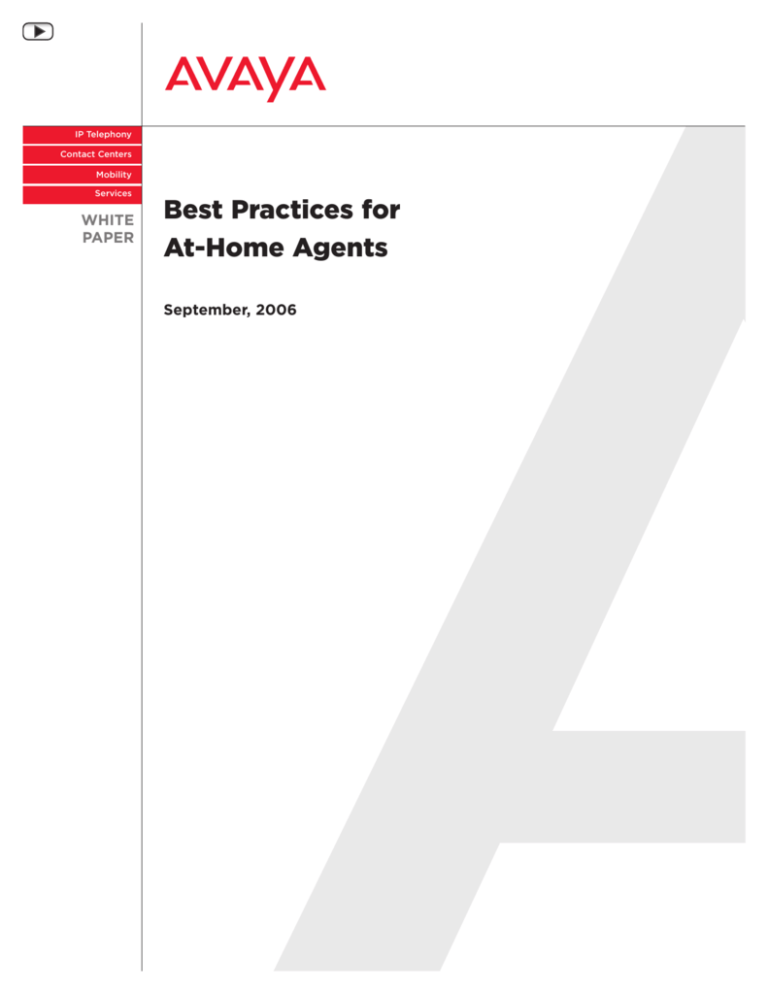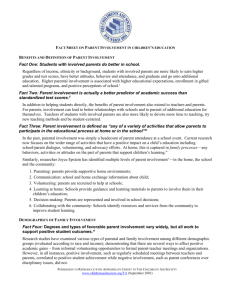
IP Telephony
Contact Centers
Mobility
Services
WHITE
PAPER
Best Practices for
At-Home Agents
September, 2006
avaya.com
Table of Contents
Section 1: At-home Agents On The Rise......................................................................... 1
What Is An At-home Agent?....................................................................................................... 2
Why Use At-home Agents?......................................................................................................... 2
Motive #1: Finding And Retaining The Best Agents....................................................... 2
Choose The Best Agents From A Larger Pool Of Candidates........................................................... 2
Overcome Agent Scarcity In High-employment Sectors................................................................. 2
Handle Peak Periods And Provide 24x7 Service........................................................................... 3
Make Good Agents Want To Stay................................................................................................ 3
Motive #2: Reduce Costs And Increase Efficiencies. ..................................................... 3
Motive #3: Ensure Business Continuity............................................................................ 4
Scenarios For Business Continuity.............................................................................................. 4
Motive #4: Respond To Transportation And Environmental Concerns........................ 4
Fuel Prices Become A Recruiting Asset....................................................................................... 4
How Was Your Commute?.......................................................................................................... 5
Breathing Easier With At-home Agents........................................................................................ 5
Success With At-home Agents: Six Best Practices......................................................... 5
Best Practice #1 - Establish At-home Agent Policies..................................................... 5
Document The Work-at-home Policies And Procedures.................................................................. 5
Guidelines In Creating Policy..................................................................................................... 6
Best Practice #2 Select The Right People For The Job................................................. 6
Select The Right Job For Each Person........................................................................................ 6
Make A Plan For Training........................................................................................................... 6
Give It A Try............................................................................................................................. 7
Reward Good Performance......................................................................................................... 7
Best Practice #3 - Ensure A Good Working Environment ............................................ 7
Dedicated And Secure Work Area............................................................................................... 7
Ergonomic Furniture And Desktop ............................................................................................. 7
Noise-free Environment............................................................................................................. 7
Balancing Life And Work .......................................................................................................... 8
The Basics: PC, Telephone, Headset .......................................................................................... 8
Software And Softphone ........................................................................................................... 8
Access To All Contact Center Features........................................................................................ 8
avaya.com
Connectivity............................................................................................................................. 9
Best Practice #5 – Make Experts Readily Available. ...................................................... 9
Best Practice #6 - Monitor And Manage.......................................................................... 9
Service Observing..................................................................................................................... 9
Provide Pointers For Improvement............................................................................................ 10
Include Agents In Team Meetings............................................................................................. 10
You Can Do This!............................................................................................................... 10
avaya.com
“Alpine Access has
experienced 60-70
percent growth since
inception. We expect
that trend to continue
over the next three to
five years, as broad
adoption of the homebased model occurs
in industries such as
financial services,
travel, retail and government.”
– Christopher
Carrington,
President and CEO,
Alpine Access, Inc.,
which has 7,500 at-home agents in
five states.
What is your mental image of an at-home agent? Is it of a smiling, professional agent diligently serving customers? Or do you see a pajama-clad loafer muting “Oprah!” to take an occasional call? Are you envisioning a progressive, cost-saving contact center strategy? Or does the very idea conjure up fears of personnel
problems and management mayhem?
From your customers’ perspective, the agent must be so professional as to be indistinguishable from an in-office agent. And from a management perspective, it had better be cost effective.
Fortunately, at-home agents can be both professional and cost effective.1 The strategy is working for many
companies, and the trend is catching on. Section 1: At-home Agents On The Rise
Today, an estimated 112,000 home-based agents work in the United States. IDC, an information technology
consulting firm, predicts the number will almost triple, to nearly 330,000 by 2010. That’s about equal to the
population of St. Louis, Missouri.2
Confirming this trend, Avaya has observed a significant increase in the number of companies employing work-at-home agents. Even more companies are actively planning such programs, or are in the exploration
stages.
Avaya contact center experts recently interviewed several companies in depth about their programs, to learn
about the drivers behind this trend. Those companies span industries and geography; they include Alpine
Access, Sitel, UpSource, VOXCOM, Visiting Nurse Service of New York, and others.
In this paper we will share what we learned. We’ll look at motivations for using home agents, and will share
what we learned from companies in the form of best practices for at-home agents.
“In the call center
industry, the number
of home agents is
growing by leaps and
bounds.”
Are you using work-at-home agents today?
5%
Yes
29%
42%
– Jack Heacock,
senior vice president
at The Telework
Coalition, quoted in
CRM Buyer.
Not Yet, but we’re already in
the planning stages
No, but we may be interested in
the future
No plans to implement at
this point
24%
Avaya polled 300 webinar attendees in July, 2006, about their plans and reasons for
implementing at-home agent programs. Two thirds of the respondents are using at-home
agents today, or are actively planning on it.
1 - http://www.businessweek.com/magazine/content/06_04/b3968103.htm
2 - http://www.census.gov/popest/cities/SUB-EST2004-4.html
COMMUNICATIONS
AT THE HEART OF BUSINESS
What Is An At-home Agent?
“Homeshoring takes
off as moms and others provide an
alternative to offshoring”
– BusinessWeek,
Jan. 23, 20063
An at-home agent is a contact center agent who works solely from home. The best practices described in this
paper do not necessarily apply to every telecommuter, virtual office worker, or home-based business — those
are more general topics than that of at-home agents.
An at-home agent does not have office space at a company facility. This expense would negate some of the
important benefits of at-home agent programs. The employment model varies: agents may be on payroll, on
commission, or work as independent contractors.
Why Use At-home Agents?
During our conversations with several companies using at-home agents, we learned the top four motives for
initiating these programs. We further confirmed these findings by asking 300 webinar attendees to rank those
motives.
“Now able to lure
more seasoned workers into these
hard-to-fill positions,
U.S.-based contact
centers … are feeling
more confident in the
face of offshore competition.”
– Computerworld,
May 15, 20064
For 1-800-FLOWERS.
com, an offshore trial
“was a reminder that
customer service is as
much about psychology
as technology. Florists
often double as condolence therapists,
interior design coaches, and relationship strategists.”
– Computerworld,
May 15, 2006
The first two are not surprising, but their priority order seems to be a product of global competition. The third
and fourth are indicators of a changed 21st-century business climate. We begin with the top-ranked motive for
at-home agents: attracting and keeping great employees.
Motive #1: Finding And Retaining The Best Agents
Using at-home agents allows contact centers to tap into a large pool of agents. Geography need not be a barrier to recruiting talented people.
Choose The Best Agents From A Larger Pool Of Candidates
Alpine Access, a large outsourcer, says all of their 7,500 agents work from their homes. Alpine gets between
1,000 and 1,500 job applications per week. Those numbers suggest that the work-at-home criteria are far
from hampering Alpine’s recruiting efforts.
“By choosing from this much larger pool of candidates, we’re better able to match people to their passion,”an
Alpine representative told us. “For example, when hiring an agent to answer calls for a clothing company, we
can find someone who already shops there, someone who’s enthusiastic and knowledgeable about their clothing lines. Their enthusiasm reflects in their work.”
Personal mobility restrictions are no longer an issue when recruiting. The candidate pool continues to expand
by adding the home bound, physically disabled, stay-at-home parents, and senior workers.
Overcome Agent Scarcity In High-employment Sectors
VOXCOM, a Canadian company, told us, “Our unemployment rate in Alberta is around four percent, which
means many of the call centres in our province are searching for new ways to find people, and to retain
the ones we have.” The company is launching an at-home agent program for non-emergency call center employees because “it’s an employee market right now — the technology we’ve implemented allows us to be
flexible when recruiting new employees and allows us to provide options for existing ones.”
3 - http://www.businessweek.com/magazine/content/06_04/b3968103.htm
4 - http://www.computerworld.com/action/article.do?command=viewArticleTOC&articleId=111243
avaya.com
Handle Peak Periods And Provide 24x7 Service
“We expect to be six
times the size that
we are today in three
years... That’s the
demand we are seeing.”
– Angie Selden,
chief executive of
Willow CSN, an outsourcing company,
quoted in the Miami
Herald, March,
2006.5 Willow CSN
currently has 3,000
agents in 37 states.
“Now able to lure
more-seasoned workers into these
hard-to-fill positions,
U.S.-based contact
centers are doing
more than improving
efforts to appease
callers. Top officials
at these call centers
say they are also
feeling more confident in the face
of offshore competition. Both
trends stem from the
fact that at-home
workers, especially
those in tedious positions, almost
always turn out to be
happier employees.”
– Computerworld,
May 15, 2006
Contact centers gain flexibility in staffing by providing more flexibility to employees through an at-home agent program.
Visiting Nurse Service of New York found it difficult to hire nurses to work the night shift, since many good
candidates were unwilling to commute into midtown Manhattan late at night. They are solving that problem
with at-home agents.
Jupiter Shop Channel, Japan’s largest home shopping channel, offers an at-home option to attract agents to
work shifts that are otherwise hard to staff, such as the overnight shift.
Still other companies are handling peak demand by having agents log in from home on an as-needed basis.
Make Good Agents Want To Stay
Can at-home agent programs increase employee loyalty and reduce turnover? The numbers speak for themselves. At Alpine Access, almost every agent — 96 percent — says they would recommend it as a good
company to work for. On employee satisfaction surveys, 91 percent are either satisfied or very satisfied. With
happy agents, contact centers have less to worry about from competitors luring away their best agents.
Motive #2: Reduce Costs And Increase Efficiencies
It is simply cheaper to move bits than bodies. Consulting firm IDC finds the typical costs for an agent in a
brick-and-mortar facility are US $31 per hour, compared to $21 per hour for at-home agents.
If you are using (or planning to use) home agents,
what is your primary motivation?
3%
9%
Attract/retain more highly
qualified agents
44%
12%
Save $$ by reducing or
eliminating bricks & mortor
Provide Business Continuity
Reduce enviromental impact
of commuting
32%
Other
Webinar poll respondents confirmed Avaya's findings. Recruiting, cost control, and
business continuity are the three top motivators for implementing at-home agent
programs. Those who responded "Other" were asked to elaborate. Their motivations
included increasing quality, overcoming facilities constraints, recruiting the disabled and
retirees, covering undesirable shifts, and enhancing their ability to scale up and down
quickly.
5 - http://www.miami.com/mld/miamiherald/business/special_packages/business_monday/14181446.htm
COMMUNICATIONS
AT THE HEART OF BUSINESS
At one technology company we spoke with, their engineers have become more efficient by playing dual roles.
When service engineers are not on customer sites, they log in as agents from their homes to provide call-in
assistance. It helps them take advantage of otherwise lost time, and helps the company stay competitive.
These first two motives are practical reasons for using at-home agents, reasons that have been talked about
for over a decade. In recent years, noteworthy events and trends have generated much more interest lately in
using at-home agents.
Motive #3: Ensure Business Continuity
In the finance sector, companies have thought through the value of business continuity. We interviewed eleven
financial companies to learn how they view it. Almost every company we talked with has a plan — or is making a plan — to use at-home agents to maintain business continuity. They explained three broad scenarios
where their business continuity would depend on at-home agents.
Scenarios For Business Continuity
First, any company anywhere in the world could lose a contact center temporarily due to damage from a natural disaster, an accident, or a deliberate act. Having agents trained and equipped to work at home
removes the contact center from the company’s worry list. During repairs, agents would work from temporary
locations. This could be a standby facility, if the company has invested in one. Even if a facility could be
arranged on short notice, physical workspace might still be limited. At-home agents, meanwhile, continue
serving customers.
Secondly, a contact center facility might be rendered unreachable or unusable, even though it is not physically damaged. Agents could be forced to stay away by such events as quarantine, contamination, or
threat. Transit strikes, blizzards, or gas shortages could make it impossible to fully staff a facility. But a call
center could implement a backup plan using at-home agents, if they are prepared.
Finally, contact centers might face the long-term effects of a natural disaster or large-scale infrastructure failure. Events such as hurricanes Rita and Katrina would require workers — even those who work at home
— to relocate. Situations such as these are not the time to start an at-home agent program; if a contact center already has a program in operation, then it has significantly reduced the negative impact of this scenario.
Localized events such as power outages can affect any building, even an agent’s home. But when one at-home
agent’s neighborhood is affected for a day, the impact is insignificant compared to losing an entire contact
center for an hour.
Motive #4: Respond To Transportation And Environmental Concerns
Concerns about fuel prices, commute times, and the environment are driving up interest in at-home agent
programs.
Fuel Prices Become A Recruiting Asset
Centrally located contact centers are an economical model, as long as worker transportation is inexpensive.
We may have seen the end of cheap gasoline, and current prices are hitting many commuting wage earners
hard. Employers can position fuel savings as a real benefit for agents working from home.
avaya.com
How Was Your Commute?
• Tax advantages-There may be tax
advantages for
at-home agents,
due to variations in
state and local
taxes. For example, an
employee who
works for a
New York company but
lives in Nevada
(which has no
state income tax)
might be able to
work from home
and thereby
avoid paying
state income
taxes. Employers
and employees
should obtain
advice on applicable tax
regulations when
considering
arrangements
such as these.
Commute time is another concern of agents considering a new job offer. Using popular technologies, such as
IP telephony, contact centers can eliminate distance as a factor in recruiting. IP telephony lets enterprises
extend their contact centers. In the case of at-home agents, technology is putting agents to work not in far-flung geographies, but closer to home.
Breathing Easier With At-home Agents
We would be remiss to discuss at-home agent programs without mentioning the climate benefits. Alpine
Access has measured the environmental impact of their 7,500 at-home agents for a twelve-month period ending in 2006:
• 2.5 million pounds of air pollutants eliminated
• 900,000 gallons of gas saved
Success With At-home Agents: Six Best Practices
Once a contact center has decided to deploy at-home agents, learning from others can enhance the success
of these programs. The following six tips emerged from our interviews with companies who are using at-home
agents.
Best Practice #1 - Establish At-home Agent Policies
Each company has a set of criteria for successful alternative work arrangements. If a company already has a
policy for telecommuting, it may need to create a few additional criteria for at-home agents.
Document The Work-at-home Policies And Procedures
A written policy should govern at-home agents with clear and uniform rules. This policy should also make
clear that all company policies apply — not just those specifically for at-home agents. Common examples are
e-mail use and customer privacy. Sitel provides a paper shredder to at-home agents and requires that they
shred any confidential information, such as customer credit card numbers.
At-home agents need to know how the company’s administrative process works in their situation. They need
access to some form of the corporate directory, to contact various support departments within the company.
They also need advice on:
• How to file an expense report
• Where to get office supplies
• How to mail a contract or ship a package
• Where to order computer equipment
• How to report problems
COMMUNICATIONS
AT THE HEART OF BUSINESS
Guidelines In Creating Policy
• Independent
contractors-Some companies
use independent
contractors for
at-home agents,
while others use
regular employees.
Correctly classifying
employees and
independent
contractors
is important.
Misclassification
could subject an
employer to back
taxes and penalties. An
employer may
also face consequences for
failure to extend
the coverage
of its employee
benefits plans
to independent
contractors later
deemed to be
employees.
Here are some of the questions that should be answered in a clear policy for at-home agents.
• Who is eligible? Make it clear whether at-home work is an option for every employee. Some agent positions
need to have a presence in the office.
• Where do they work? Specify workspace arrangements for a dedicated, quiet, secure workspace (for more
detail, see Best Practice #4). Make it clear that they will not have a desk at the company’s offices.
• Who is responsible for what costs? Spell out who will pay for the computer, high-speed Internet access,
additional phone line, furniture and other office needs.
• What are the schedule policies? If at-home agents are required to adhere to a specified schedule, explain
the schedule, as well as how schedule changes will be managed and communicated.
• Are there any tax implications for the agent? The typical agent will have no experience with this arrangement, whereas most employers have accounting staff qualified to answer tax-related questions.
• Are there any unwritten rules? One company’s policy includes this proviso: “This document is intended to
provide general guidelines for managers. Managers are expected to use appropriate discretion; therefore,
these guidelines may not be followed in every situation… (company) reserves the right to change or discontinue these guidelines at any time and without notice.”
Best Practice #2 Select The Right People For The Job
Some employees are terrific people and good workers, but may not be suited to work at home. Personality
is only one aspect of this. Most at-home agents will have access to customer-sensitive information, such as
credit card numbers. Sitel makes it a part of their selection process to do background checks.
Select The Right Job For Each Person
In addition to making sure the person is right for the situation, verify that the situation is right for the person.
With each candidate — whether a new hire or an existing agent — the manager and employee should walk
through the policies and procedures together. Focus on job responsibilities, organizational and departmental
goals and objectives, customer impact, and employee’s work performance.
Establish the manner and frequency of communication between the agent and the manager to ensure expectations are being met.
Make A Plan For Training
How will new agents be trained, if they work at home? Some companies avoid this question by placing only
tenured agents in at-home arrangements.
For those who must come into the office for initial training or continuing education, distance may become an
issue that the company must accommodate. One approach is to provide all training on-line.
avaya.com
• Home at workSet up an at-home agent
office in your
contact center,
for training and
to set an example. Be
careful, though
-- your in-office
agents might
start asking for
couches and
coffeemakers in
their cubicles.
• Ergonomics It is prudent
for employers
to maintain
ergonomics
standards as
part of their
at-home policy.
An employer
must provide
an ergonomically appropriate workspace in
those jurisdictions with an
applicable ergonomics standard, regardless of
whether the
employee works
at home or in
the office. Even
in states with
no standard,
an employer
remains generally responsible for
the health and
safety of its
employees and
may be responsible for
on-the-job injuries under
workers’ compensation
laws.
Give It A Try
Screening cannot catch every potential problem. Some companies specify a formal trial period, during which
the employee must meet the performance criteria to continue working at home. If an agent’s performance falters during the trial period — for example, their AUX work time is excessive — you may want the flexibility
to end the at-home arrangement for that agent.
It might be the agent who needs that flexibility. Kay Phelps, a Senior Manager for Avaya, advises companies
to build in some slack: “Trial periods provide a way for manager and agent to save face. Have an agent work
at home for a week or two, then come back to the office for a few weeks. Then they have a natural opportunity
to choose whether to make it permanent, or to retreat from the arrangement without shame.”
Reward Good Performance
The Avaya Customer Contact Council, a select group of senior executives from 28 market leading companies
committed to improving performance and profitability in customer contact, tells us that at-home arrangements are used as a perk for top performers.
Best Practice #3 - Ensure A Good Working Environment
Prospective at-home agents may not have accurately pictured themselves working at home. Tell them what
works based on experience, and spell out what you expect of their workspace. The written policy should
include guidelines for the working environment, and these guidelines should be discussed with at-home agent candidates.
Dedicated And Secure Work Area
Almost any room can serve as an office, but selecting the right space is essential to success. A dedicated
office maximizes the agent’s efficiency and comfort.
Explain how the agent’s workspace protects privacy and security. Privacy applies to the company and its customers. Agents are responsible for protecting information, including customer data and proprietary company information, such as pricing.
Security applies to preventing fraud, but also to protecting software and hardware from theft or misuse.
Ergonomic Furniture And Desktop
An employee’s health is, in part, the employer’s responsibility. We spoke with a company that provides an
ergonomic chair for at-home agents and provides ergonomics information and diagrams in their employee
handbook.
How does this apply to the self-employed? Some outsourcers expect agents to operate as independent contractors who provide their own office equipment. Nonetheless, the company might make ergonomics suggestions, if only for the agent’s continued productivity.
Noise-free Environment
Agents are the voice of their company, no matter whether they speak from a call center or a home office. At-home agents must manage interference from such noises as door bells, children, traffic, pets and neighbors.
COMMUNICATIONS
AT THE HEART OF BUSINESS
This should be assessed when you are selecting candidates. The right people come with the right space. Their
home environment must make sense.
Balancing Life And Work
Agents who are temperamentally fit for work at home sometimes turn out to be workaholics. An overtime policy should be sufficient to manage this and prevent agent burnout.
Best Practice #4 - Equip Agents To Succeed
Even good agents will be only as good as their tools. Here are some aspects to consider about agent equipment.
The Basics: PC, Telephone, Headset
Agents will need a PC, a headset, and either VoIP or a separate telephone line. If your company provides the
PC or enforces system requirements, your Help Desk will thank you.
Unlike commercial desk phones, not all home telephones have handsets that unplug — and that generally is a
prerequisite to connecting a headset.
Document your policies and procedures to tell the at-home agent:
• How they obtain a computer, or how to determine that their computer meets the company’s minimum system requirements.
• How they get their equipment set up, whether through a Help Desk or third party.
• How they connect to the contact center using a VPN, including the login and password procedures.
• What backup and recovery procedures are in place.
• How to get Help Desk support.
Software And Softphone
The company, not the agent, selects the software and softphone. UpSource tells us that when they can control
the content of the PC, implementation and connection problems typically are not an issue.
When that level of control is not possible, consider providing troubleshooting tips and installing a remote-control tool so the Help Desk can troubleshoot problems remotely. Popular remote-control tools include
WebEx, Symantec pcAnywhere and Altiris Carbon Copy, but there are many other options.
In controlling what content is on agent’s PC, consider what content should not be on PC. Sitel takes this
approach: It provides a standard disk image for at-home agents’ PCs. Booting from this image addresses security issues as well, mitigating the risk of introducing viruses from the agent’s own PC.
Access To All Contact Center Features
At-home agents must not be, in technology terms, second-class citizens. They must be at functional parity
— they need the same features, the same access to supervisors — as in-office agents.
avaya.com
Connectivity
• “Presence” is a
technology that
is familiar to
users of instant
messaging,
where a list of
names is accompanied by
icons indicating
whether each
person is logged
in. When presence is
incorporated into
a contact center,
finding an expert
is just as easy
for the remote
agent as for the
in-office agent.
Using a second analog phone line provides consistent quality without network engineering. There is, however,
an up-front activation cost and ongoing monthly expense. The trend is moving toward VoIP. VoIP eliminates those costs, as well as toll charges for distant agents. But more importantly it facilitates setting up the phone as a virtual extension, with full feature transparency.
VoIP depends on a solid Internet connection, so do not take broadband for granted. Sitel told us that one of
their biggest challenges was ensuring that remote agents had dependable Internet access, even in some major
metropolitan areas.
Fortunately, IT tools are available to evaluate broadband performance. Run a network assessment to ensure
good voice quality, and address its findings. Unless addressed beforehand, NAT, throughput, and firewall
issues can create headaches at the beginning of at-home agent programs.
“Whatever your IT department tells you about how good their network is, VoIP is going to really test it,” advises Bill Jolicoeur, Avaya Product Manager. “Once you press beyond this stage, though, things will settle down.”
Best Practice #5 – Make Experts Readily Available
At-home agents need access to the same expert pool as those who have supervisors and expert resources just
over the cubical wall. With today’s technology, at-home agents need not go it alone.
Contact center solutions provide instant messaging and other capabilities integrated into the agent softphone.
These features tell at-home agents who is available for assistance. An agent simply clicks to connect with an
available supervisor or expert.
With these types of tools, at-home agents are able to meet customer needs without having to transfer calls.
Delivering one-call resolution to more of your customers can increase satisfaction while enhancing the cost
savings of using at-home agents.
Best Practice #6 - Monitor And Manage
How do you know that your at-home agents are meeting your performance standards? Technology lets you
monitor them, just as you would in the office.
Alpine Access told us that they are able to hire a more experienced and educated staff for their at-home agent
program. These more mature agents have an average age of 38, compared to the typical range of 18 to 29,
Alpine Access says, and require less management oversight.
Service Observing
Today’s contact center systems provide the same monitoring capabilities for at-home agents as for in-office
agents. Supervisors can observe interactions, record agent calls, capture screens, and report on the full range
of at-home agent activities.
COMMUNICATIONS
AT THE HEART OF BUSINESS
10
Provide Pointers For Improvement
At-home agents need to meet the same continuous improvement goals that apply to all agents. As you manage
a group of at-home agents, you will learn from their collective experience and gain perspective that you can
feed back to the group. You are the repository for their collective experiences, a resource they can turn to.
Schedule times for management feedback. Predictable check-in times are reassuring to at-home agents.
Alpine Access found that sending a hand-written note to an at-home agent is an effective added touch.
Keep Training At-home Agents
Call centers are turning to electronic training for at-home workers. LiveOps provides agent help and training by
a variety of means.
“All training is readily available by instant messaging and conference calls, and it’s built into the available
data on my company’s Web site,” says David Randall, a call center agent at LiveOps.
Include Agents In Team Meetings
At-home agents need to be included in team meetings and events to stay connected socially and culturally.
Agents who choose at-home work arrangements are sometimes reclusive and do not want to come into the
office for meetings.
Many companies are attuned to the need for acculturation for every employee. Team spirit, professionalism,
and a sense of individual value are difficult to communicate over the phone to employees. You may find that
it is good for the employee, and for the company, to see at-home agents in the office once in a while.
You Can Do This!
At-home agents represent an opportunity to expand and improve your call center team. And they can be a
form of insurance to keep your business running if disaster strikes.
Go slowly. Think through the people, policies, and procedures that you will need to run an effective program.
Avaya offers the leading systems, applications and services to go with them. Call us for more advice, tailored
to your situation.
For more information on how Avaya can make at-home agent programs work for your enterprise, contact your
Avaya Client Executive or Authorized Avaya BusinessPartner, or visit us at www.avaya.com
About Avaya
Avaya enables businesses to achieve superior
results by designing, building and managing their
communications infrastructure and solutions. For
over one million businesses worldwide, including
more than 90 percent of the FORTUNE 500®, Avaya
embedded solutions help businesses enhance
value, improve productivity and create competitive
advantage by allowing people to be more productive
and create more intelligent processes that satisfy
customers.
For businesses large and small, Avaya is a world
leader in secure, reliable IP telephony systems,
communications applications and full life-cycle
services. Driving the convergence of embedded
voice and data communications with business
applications, Avaya is distinguished by its
combination of comprehensive, world-class
products and services. Avaya helps customers
across the globe leverage existing and new
networks to achieve superior business results.
COMMUNICATIONS
AT THE HEART OF BUSINESS
© 2006 Avaya Inc. All Rights Reserved. .
Avaya and the Avaya Logo are trademarks of Avaya Inc. and may be registered in certain jurisdictions. .
All trademarks identified by ®, TM or SM are registered marks, trademarks, and service marks, .
respectively, of Avaya Inc., with the exception of FORTUNE 500 which is a registered trademark of .
Time Inc. All other trademarks are the property of their respective owners.
10/06 • MIS3270
avaya.com







